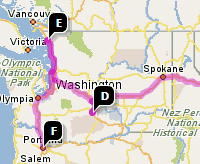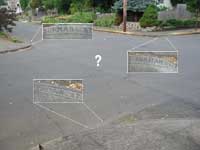Emily and I rode a large section of the 40 mile loop yesterday. We rode from her place at John’s Landing to the Springwater Corridor and followed it out to Gresham, then north on 257th to Marine Drive, Marine Drive to I-205, the I-205 path back to the Springwater, then back to John’s Landing. 46.6 Miles. Here’s the replay with a few observations of my own (read: sarcasm)

To start with, we had to cross the Sellwood Bridge. If it wasn’t my second time crossing it, and I didn’t have an enjoyment for trials riding, I’d hate it. And I get the feeling that most people do hate the Sellwood bridge, at least when trying to cross it. You do get a nice view from atop it though, and you can see our lovely city to the north and an active, tree lined river to the south. I’ve heard that the Springwater is supposed to connect with the river trail at some point, but we weren’t sure if it was done, so we followed Tacoma St. through Sellwood to where it intersects Johnson Creek Blvd and joined the Springwater Corridor trail.
The Springwater Corridor is probably one of, if not the best bike trails I’ve been on. The trail itself is perfectly flat – owing to it’s history as a railway grade. The section from Oaks Bottom into town has been recently paved and you sometimes have trouble remembering to enjoy it as you can really pick up a nice clip. East from Sellwood winds though neighborhoods and wooded areas following Johnson Creek much of the time, and crosses major roads with crosswalks and lights. The trail also passes a number of parks, such as Beggars Tick and Powell Butte, where we took a small side trip.

Both Emily and I recently got cyclocross bikes, and this was our first chance to try them on a trail. The climb up to the “summit” was easy and I was pleased by the performance by Jake. At the top of the Butte are the remains of a former orchard and a great view of the surroundings. We followed the orchard trail around the butte to get the full panorama. There wasn’t a cloud in the sky, which should have meant a great view, but a dirty brown smog blanketed the lowlands and the air was quite hazy. Still, the view of Portland, Vancouver, Camas, Gresham, Oregon City, and the four tops (Mt. Jefferson, Mt. Hood, Mt. Adams, and Mt. St. Helens…er… 3 tops anyway). Activity started to pick up by this time, and what looked like a group of school kids (on a Saturday?) an parents were at the top enjoying graham crackers and the view.
Back on the trail we started to see other riders and walkers out as we approached Gresham. We also saw a couple Nutria, some mallards, 3 pair of wood ducks, and a peeved domestic goose who was fed up with our gawking.
We got off the trail again at Gresham’s Main City Park to grab some lunch at the farmer’s market. We somehow ended up in the Teddy Bear Parade trying to follow a float that said it was from the farmer’s market, and eventually found our way back. Sadly, there wasn’t really anything to eat other than hot dogs so we stopped at Jazzy’s Bagel shop to refuel. I think farmer’s markets should have a giant public grill and some olive oil and salt so people can buy fresh veggies and grill them on site. That would have been a terrific lunch.
From Gresham, we followed the trail to Hogan Rd. then north to Division to 257th because the map suggested the trail was incomplete beyond that point. We followed 257th down to Marine Dr – and although there was a bike lane on the road, it was probably the least interesting and least inviting part of the ride. But once you get past the confusion of the Troutdale outlets and the Troutdale Airport, the path starts up again and winds between the Columbia River and parts of the slough. To our amazement, we had just been looking at this area from the top of Powell Butte.

Eventually , you end up on the levee or a path just below the levee on the river side. Mt. Hood is behind you (or in front, depending on your direction) and the occasional overhead jetliner. It’s fun to watch the barely floating giants pass overhead at a speed which seems inadequate to keep them in the air. You can expect some headwind along this stretch since it’s on the river.
From Marine Dr., we took the I-205 trail south to the Springwater. The trail gets a little confusing in some places where you cross in traffic, but it’s much nicer than you’d expect. It’s surprisingly quiet on the trail. I was surprised and pleased by the courtesy of drivers who stopped to let us cross the major arterial. I know there were crosswalks, but still – even as a pedestrian conscious driver, I often race to beat them.
By this time, we were both quite tired and quickly cruised back on the Springwater trail to Johns Landing. We were both pleased to know that we could – should it ever become necessary – ride the entire trail. In fact, once the 40 mile loop is complete, it would be a blast.
For the complete set of pictures – see here. For previous section postings, see here.





